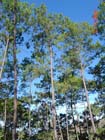
Stand of trees in habitat, La Bulera, Jalisco [Mauricio Mantilla Blandon, 2006].
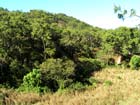
P. jaliscana stand near El Tuito, Mexico [C.J. Earle, 2007.02.13].

Isolated old trees growing near El Tuito, Jalisco [C.J. Earle, 2007.02.13].

Seed cone from tree in habitat, iNaturalist observation 100240524 [Pablo Carrillo-Reyes, 2020.02.14].
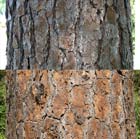
Bark on trees near El Tuito; upper stem is 45 cm diameter, lower is 90 cm [C.J. Earle, 2007.02.13].
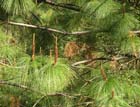
Foliar units with actively elongating candles; tree near El Tuito [C.J. Earle, 2007.02.13].
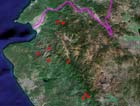
Range of Pinus jaliscana (Dvorak et al. 2000). Dots indicate centroids of the nine populations found by Dvorak et al. (2000). Area shown is in western Jalisco. Width of image is approx. 160 km. Basemap from Google Maps.

A twig 6-7 mm in diameter, showing decurrent pulvini [C.J. Earle, 2007.02.13].

Nearly mature pollen cones, collected near El Tuito [C.J. Earle, 2007.02.13].

Seedling 12-13 cm tall, natural regeneration in a logged over area near El Tuito [C.J. Earle, 2007.02.13].

Recently germinated seedlings [Facebook post by Victor Hugo Garza Guajardo, 2020.03.15].
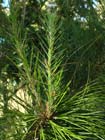
Understory saplings 3 m tall may still bear some juvenile foliage [C.J. Earle, 2007.02.13].

Pinus jaliscana
Pérez de la Rosa 1983
Common names
Ocote, pino de Jalisco [Spanish], Jalisco pine (Perry 1991).
Taxonomic notes
Synonymy (Farjon 1998):
- Pinus patula var. jaliscana (Pérez de la Rosa) Silba 1985;
- Pinus macvaughii Carvajal 1986;
- Pinus oocarpa var. macvaughii (Carvajal) Silba 1990.
Type Mexico: Jalisco: Pérez de la Rosa 370, location approx. 20.4° N, 105.2° W.
Most authors agree that this pine is closely related to P. oocarpa. Price et al. (1998) place it in Pinus subgen. Pinus section Pinus subsection Oocarpae, along with a number of other species native to Mexico. A molecular study elucidating relationships within this group suggests that P. jaliscana is not especially closely related to the other species, having likely diverged from a common ancestor in the early Pliocene, and shares a clade with such more widespread species as P. patula, P. taeda, and P. teocote (Hernández-León et al. 2013).
Description
Trees to 20-30(-35) m tall and 50-80(-100) cm dbh, with a straight trunk and ascending branches in an irregularly rounded, open crown. Bark on young trees thin, rough, reddish in large, loose scales, thickening with age to 1.5-3.5 cm and fissured into longitudinal plates; the bark exfoliates distinctively into large, very thin (0.5 mm) plates and accumulates around the bases of old trees. Branchlets long, slender, flexible; pulvini disintegrate in 2nd or 3rd year to leave a fairly smooth branchlet. Leaves in fascicles of (3-)4-5, 12-16 cm long and very slender (0.5-0.8 mm) but not drooping, with finely serrate margins and stomata on adaxial and abaxial surfaces; resin canals (1-)2-3(-5), septal (occ. internal); fascicle sheaths pale brown, 8-15 mm long, persistent. Pollen cones crowded at the end of new shoots, ovoid-oblong to cylindrical, 12-18 × 5-6 mm, subtended by scarious bracts, purple-yellow turning light brown. Seed cones subterminal, single or in whorls of 2-3 on 0.7-1.5 cm long stout, curved, scaly peduncles that remain attached to the fallen cones; purple-red, maturing in 2 seasons to become at maturity long-conical, tapering at base and apex, (4.5-)6-8.5(-9.8) cm long and (3-)4-5(-6) cm wide when open. The cones ripen in winter and are serotinous. Cone scales number 90-115, hard, strong, stiff, aphophyses flattened, slightly thickened, slightly transversely keeled, with a 3-4 mm wide depressed umbo bearing a very small, early deciduous prickle. Seeds dark brown, 3.5-6 × 2-3.5 mm, with an articulate pale brown wing 12-17 × 5-8 mm. Wood is yellow-white with creamy white sapwood (Perry 1991, Farjon and Styles 1997, Dvorak et al. 2000).
The long, strongly reflexed peduncle, thinly exfoliating bark, and very slender but not drooping needles are distinctive field characters (Perry 1991). Farjon and Styles (1997) regard it as very similar to Pinus herrerae, and provide the following comparison of characters:
| Character | Pinus jaliscana | Pinus herrerae |
| fascicles | (4-)5 leaves, rarely 3 | 3 leaves |
| resin ducts | septal (sometimes 1-2 internal) | internal, rarely septal |
| seed cones | (4.5-) 6-8.5 (-9.8) cm long | 3-3.5 (-4) cm long |
Distribution and Ecology
Mexico: western Jalisco: at 19°48' to 20°45' N in tropical and subtropical mountains. Nine populations are identified in the species' range, and are shown on the map at right. They occur at elevations of 700-1460(-2050) m. Climate is subtropical, with annual precipitation of 1500-1935 mm, a November-May dry season, and mean annual temperature 22-26° C; preferred soils are granitic, acidic, deep, and well drained. Common sites include north- and west-facing slopes, near streambanks, and other sites where groundwater is available most of the year. It usually occurs in pine-oak ecosystems, where common tree associates include P. oocarpa, P. maximinoi, P. douglasiana, several species of Quercus, and an array of broadleaf species (Perry 1991, Farjon and Styles 1997, Dvorak et al. 2000). On some sites it occurs with Juniperus jaliscana and at the highest elevation site (over 2000 m) it occurs with Abies guatemalensis var. jaliscana. It is a strongly fire-dependent species, regenerating prolifically after fires that expose mineral soils, but on poorer sites it is readily outcompeted by the other pine species mentioned above.
Although the WCMC currently reports this species a "lower risk" conservation status, its restricted range (nine known populations) and the presence of active exploitation via logging in the area contradict that status; Dvorak et al. (2000) state that it is "vulnerable" and that some populations are "critically endangered." The species thus warrants efforts at formal protection. The CAMCORE cooperative is assisting that effort with ex situ conservation efforts, but the tree continues to receive little protection in its native range, where it is currently threatened by logging and grazing activities.
Remarkable Specimens
Ethnobotany
Perry (1991) reports that it is subject to logging, but Farjon and Styles (1997) note that local use does not discriminate between it and other pines growing in the area. Local woodcutters exploit this species as readily as they do P. douglasiana or P. oorcarpa, but they note that it is softer and less resinous than these other pines (Dvorak et al. 2000).
Observations
Remarks
Like many other pines, P. jaliscana displays a number of adaptations to fire. These include serotinous cones, relatively thick bark, and self-pruning of lower branches (Keeley and Zedler 1998). These characteristics allow it to survive low-intensity fire, and to disseminate its seeds in the aftermath of high-intensity crown fires.
P. jaliscana is parasitized by the mistletoe Cladocolea cupulata Kuijt (Loranthaceae) (Kenaley and Mathiasen 2006).
Citations
Dvorak, W. S., A. P. Jordan, J. A. Pérez de la Rosa, and G. R. Hodge. 2000. Pinus jaliscana. Pp. 86-94 in Conservation & Testing of Tropical & Subtropical Forest Tree Species by the CAMCORE Cooperative. Raleigh, NC: College of Natural Resources, NCSU.
Hernández-León, Sergio, David S. Gernandt, Jorge A. Pérez de la Rosa, and Lev Jardón-Barbolla. 2013. Phylogenetic relationships and species delimitation in Pinus section Trifoliae inferrred from plastid DNA. PLOS One DOI: 10.1371/journal.pone.0070501.
Keeley, J. E. and P. H. Zedler. 1998. Life history evolution in pines, pp. 219-250 in Richardson 1998.
Pérez de la Rosa, J. A. 1983. Una nueva especie de pino de Jalisco, México. Phytologia 54:289-298.
See also
Dvorak, W. S., J. A. Pérez de la Rosa, M. Mápula and V. J. Reyes. 1998. The ecology and conservation of Pinus jaliscana. Forest Genetic Resources 26:13-19. Abstract: Pinus jaliscana is a closed-cone pine in the Oocarpae subsection that occurs from 19 to 20 degrees N latitude in tropical and subtropical areas of the mountains of western Jalisco, Mexico. This paper combines information from explorations and seed collections with existing taxonomic descriptions, to develop a more detailed account of the ecology and conservation status of P. jaliscana. Information is presented under the following headings: distribution and ecology, including description of the species, occurrence, climate, species association, role of natural and man-made fires, and diseases; soils; reproductive biology, including flowering time, cone maturation and seed dispersal, and seed yields; wood properties; conservation status; and potential as a plantation species.
Farjon et al. (1997).
López-Upton, Javier. 2003. Pinus jaliscana. Species description in the Tropical Tree Seed Manual. Available http://www.rngr.net/Publications/ttsm/Folder.2003-07-11.4726 (accessed 2007.08.31).












